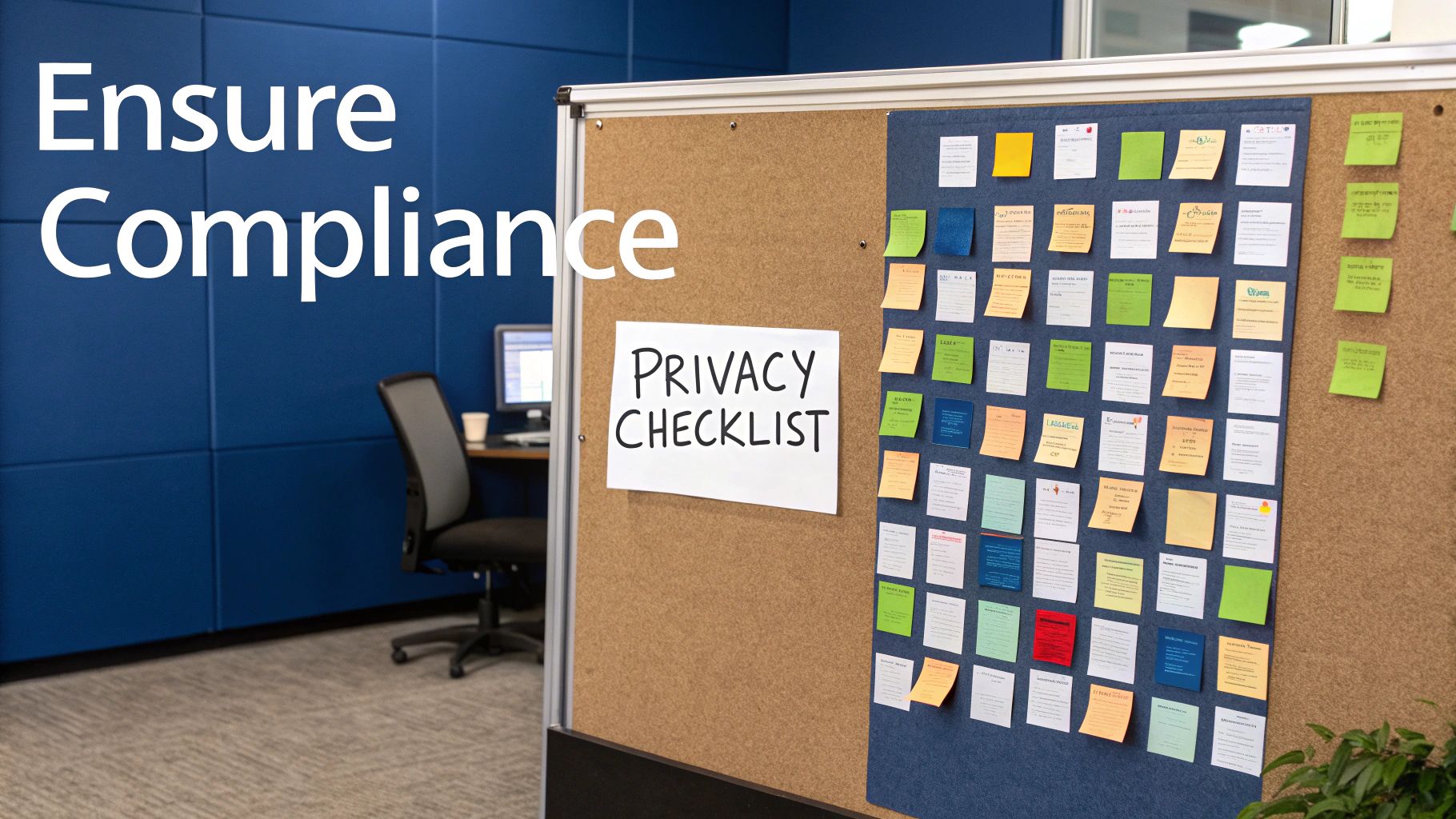Ultimate Privacy Impact Assessment Template: A Step-by-Step Guide for Businesses
Understanding Privacy Impact Assessment Templates: A Modern Necessity

Organizations must find ways to effectively use data while protecting individual privacy. This is where Privacy Impact Assessments (PIAs) play a vital role. PIAs help companies identify and address potential privacy risks in their data processing activities. By taking a proactive approach to privacy, organizations can build trust with customers and stakeholders.
The Evolution of PIAs
The practice of conducting PIAs has changed significantly over time. What started as basic compliance checklists has grown into robust risk management tools. Modern privacy impact assessment templates now include detailed components like data mapping, risk scoring, and mitigation planning. These improvements allow organizations to better understand and reduce privacy risks.
The General Data Protection Regulation (GDPR) marked a turning point for privacy assessments when it took effect in 2018. Under GDPR, organizations must conduct Data Protection Impact Assessments (DPIAs) for high-risk processing activities. This includes evaluating whether processing is necessary, assessing potential risks, and planning risk reduction measures. The regulation's requirements have driven wider adoption of PIA templates across different sectors.
The Benefits of Using a PIA Template
A well-designed privacy impact assessment template provides clear advantages. It creates a consistent, thorough approach to conducting PIAs. The template format also makes the assessment process more efficient, allowing privacy professionals to concentrate on analyzing risks and developing solutions rather than starting from scratch each time.
Adapting to Industry-Specific Needs
While standard templates are useful starting points, they need customization for different contexts. Industries face varying privacy requirements - healthcare organizations must follow HIPAA rules, while financial institutions have GLBA compliance obligations. A privacy impact assessment template should be flexible enough to incorporate these specific regulations. This ensures the assessment effectively addresses your organization's unique privacy risks. The template should also be easy to update as regulations and business practices change, making it a valuable ongoing privacy management tool.
Essential Components of an Effective PIA Template

A well-designed privacy impact assessment template helps organizations manage privacy risks proactively. It provides a clear framework for spotting potential issues early and protecting personal data throughout its use. Here are the key elements that make a PIA template truly effective.
Defining the Scope and Purpose
The first key part of any privacy impact assessment template is establishing clear boundaries. This means specifying exactly which data processing activities the assessment covers - like collecting customer information through web forms or sharing employee data with vendors. The purpose should be clearly stated too - whether it's meeting specific rules like GDPR or CCPA, or supporting broader privacy goals. A clear scope helps keep the assessment focused and on track.
Data Mapping and Inventory
Understanding your data is essential for an effective PIA. The data mapping section should create a detailed record of all personal information, including where it comes from, what types exist, where it's stored, and why it's collected. Think of it as drawing a map that shows every place where personal data moves through your organization. This helps spot weak points and evaluate risks in each area where data flows.
Risk Assessment Methodology
After mapping the data, you need a systematic way to assess privacy risks. A good template includes a structured approach using tools like a risk evaluation matrix to measure how likely problems are and how much damage they could cause. This helps sort risks by severity so organizations know which issues need attention first. For more details, see our guide on How to master your DPIA for GDPR success.
Mitigation and Remediation Strategies
Finding risks is just the start. Your template should guide you in creating specific plans to reduce or remove those risks. This could mean adding better security, training staff on privacy, or finding ways to use less personal data. The template should spell out how to put these plans into action and check if they're working. This helps organizations stay ahead of problems and follow privacy rules.
Communication and Documentation
A strong template must emphasize clear record-keeping and sharing of information. It should explain how to tell key people about assessment findings - including managers, employees and individuals whose data you handle. The template should support detailed documentation of the whole PIA process, from start to finish. Good records show compliance and help improve future assessments. Learn more in our guide about How to master your document management.
When a privacy impact assessment template includes these core elements, it becomes a valuable tool for managing data privacy and building trust.
Technology and Modern PIA Processes
Effective Privacy Impact Assessments are essential for modern organizations. Tools and software now play a key role in making PIAs more efficient and thorough. By combining smart technology with human expertise, organizations can create better assessment workflows.
Automating Key PIA Tasks
Software tools can now handle many time-consuming PIA tasks automatically. For example, data discovery tools can quickly map where personal information exists in your systems, making data mapping much simpler for your privacy impact assessment template. AI tools can also help evaluate privacy risks based on set criteria, letting privacy teams focus on analysis and developing solutions.
Smart Risk Analysis and Reporting
Advanced risk scoring systems help organizations understand privacy risks better. These systems look at data from multiple sources to identify high-risk processing activities, helping teams focus their efforts where needed most. Automated reporting tools create clear PIA reports that help keep everyone informed. According to recent data, 1,500 businesses worldwide now use specialized PIA tools like Pointerpro to conduct and manage their assessments.
Picking the Right Tools
When choosing PIA technology, focus on tools that match your needs without adding unnecessary complexity. Here are key factors to consider:
- Growth Ready: Select tools that can handle increased workload as your organization grows
- Works Together: Make sure new tools connect smoothly with your current systems
- Easy to Use: All team members should be able to use the tools effectively
The right technology turns your privacy impact assessment template into an active tool for managing privacy risks and protecting personal data. This helps build trust with customers while meeting compliance requirements.
Building Your Stakeholder Engagement Strategy

A strong privacy impact assessment requires more than just following a template - it needs active collaboration with everyone involved. By engaging stakeholders throughout the process, you ensure all perspectives are heard and considered, leading to a better assessment outcome.
Identifying Key Stakeholders
Start by mapping out who needs to be part of the assessment process. Look beyond your immediate team to include everyone affected by data processing activities, data owners, and subject matter experts. For instance, when evaluating a new customer database system, you'll want input from:
- Marketing teams
- Sales representatives
- IT departments
- Legal advisors
- Customer advocates
Creating Effective Communication Channels
After identifying stakeholders, set up clear ways to keep everyone connected and informed. This could include:
- Regular check-in meetings
- Email updates on progress
- Shared project management tools
The goal is making sure everyone stays informed and has opportunities to provide feedback. Multiple communication options help accommodate different working styles and preferences.
Maintaining Productive Relationships
Building good relationships with stakeholders is essential for success. Focus on:
- Active listening to understand concerns
- Quick responses to questions
- Respect for everyone's time and input
Regular progress updates, even small ones, show you value stakeholder involvement. According to the United States Department of Homeland Security, a thorough PIA should include input from data governance teams, system stakeholders, legal teams, records managers, and security staff. Learn more at SafetyCulture.
Frameworks for Stakeholder Mapping and Communication
Use practical tools to organize stakeholder engagement:
- Stakeholder mapping helps visualize relationships and influence levels
- Communication plans outline what information to share and when
- Regular check-ins ensure consistent updates
These frameworks add structure to stakeholder engagement while keeping it efficient. A well-planned approach to working with stakeholders leads to better privacy assessments and stronger data protection practices across your organization.
Implementing Risk Assessment and Mitigation Strategies

Creating an effective privacy impact assessment goes beyond just filling out forms. You need to actively identify risks, evaluate their impact, and create plans to address them. Smart organizations build these steps directly into their assessment process.
Identifying and Evaluating Privacy Risks
The first key step is finding where privacy risks exist in your data handling processes. This means looking at how data flows through your organization, where vulnerabilities might occur, and what threats could emerge. For example, if you collect customer information through web forms, you need to think about risks like data breaches or improper sharing. Using a risk evaluation matrix helps sort these risks by both likelihood and potential impact, so you can tackle the biggest issues first.
Developing Mitigation Strategies
After identifying risks, create specific plans to address them. Focus on solutions that are measurable, achievable, and time-bound. This could mean adding security measures, using data encryption, making data anonymous where possible, or training staff on data protection. Document all these plans in your privacy assessment. For more guidance on managing data, see our guide on data retention policy templates.
Implementing and Monitoring Controls
Put your chosen strategies into action by setting up proper safeguards. This might involve new security software, updated data procedures, or privacy training programs. Remember that implementation isn't a one-time task - you need to regularly check how well these controls work and adjust them as needed. This ongoing process helps keep protection strong.
Examples of Mitigation Strategies
Here are practical ways to reduce privacy risks:
- Data Minimization: Only collect personal data you actually need
- Access Controls: Limit who can view and change personal data
- Data Encryption: Protect data both when it's being transmitted and stored
- Regular Audits: Check compliance and look for weak points regularly
Addressing Common Pitfalls
Organizations often face challenges when putting mitigation strategies in place. Common issues include limited resources, resistance from team members, or trouble adding new procedures. The key is to address these early through clear communication, getting everyone involved, and rolling out changes in stages. A well-designed privacy impact assessment helps manage this process by organizing risk analysis and documenting your mitigation plans.
Maintaining and Evolving Your PIA Framework
A Privacy Impact Assessment (PIA) framework needs constant attention and updates to protect data effectively. Like any security system, it must adapt to new regulations, technologies and business changes. Regular maintenance helps ensure compliance and strengthens privacy protection.
Establishing a Review Cycle
Set a clear schedule to review your privacy impact assessment template. Plan reviews annually or twice per year, plus additional checks when major changes occur like new technology adoptions or process updates. This keeps your framework current with industry standards and legal requirements.
Implementing Continuous Improvement
Think of your PIA framework as a work in progress that gets better over time. After each review, make updates based on stakeholder input, audit results, and new privacy developments. You might need to refine risk assessments, update data mapping, or improve protection strategies. Learn more about managing documentation effectively: How to master document management.
Measuring Success
Track key metrics to assess your PIA framework's effectiveness:
- Number of PIAs completed
- Risks identified and fixed
- Stakeholder feedback and satisfaction
- Time to complete assessments
These measurements show what's working well and what needs improvement.
Documentation and Version Control
Keep detailed records of all PIAs, including:
- Assessment scope
- Key findings
- Risk mitigation steps
- Framework updates and changes
Use version control to track revisions and ensure everyone uses the current privacy impact assessment template. Good documentation creates an audit trail and helps share knowledge.
Practical Tips for Sustainable Compliance
- Make PIAs part of project planning: Include privacy assessments from the start of new initiatives
- Provide staff training: Help employees understand PIA procedures and privacy best practices
- Monitor industry changes: Stay current on privacy regulations and standards to adapt your framework
When followed consistently, these practices help build an effective PIA program that protects privacy and maintains compliance.
Whisperit, an AI-powered dictation and text editing platform, helps organizations manage documentation securely. With Swiss hosting, encryption, and compliance with GDPR and SOC 2, it supports strong data protection practices. Learn more about Whisperit's privacy and security features.